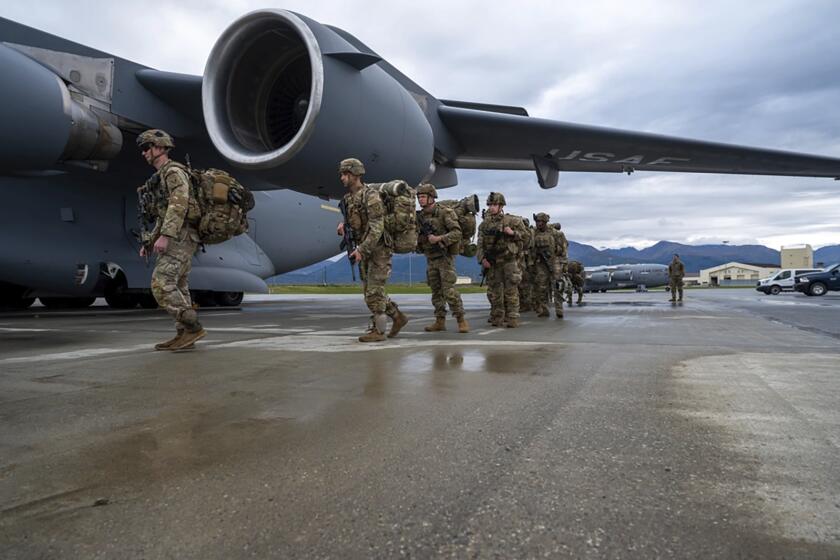Border agents relying on outdated surveillance equipment
WASHINGTON — An Obama administration plan to install new cameras and improved ground sensors along the Southwest border has stalled, potentially creating unnecessary dangers for agents there.
Officials say a false alarm from a ground sensor in southern Arizona was to blame when several U.S. Border Patrol agents rushed to the remote canyon on horseback Oct. 2, shortly after midnight. For reasons still unclear, the agents opened fire on one another. One was killed and another wounded.
The incident has raised concerns that a deteriorating network of more than 12,800 ground sensors, as well as other outdated technology, could endanger the lives of those who police the long border with Mexico.
U.S. Customs and Border Protection “must replace outdated sensors with more modern, effective technology that can assist the Border Patrol in securing our borders while not sending agents into the field unnecessarily,” said Rep. Bennie Thompson (D-Miss.), the senior Democrat on the House Homeland Security Committee.
The initiative, called the Arizona Border Surveillance Technology Plan, was launched in January 2011 and was projected to cost $1.5 billion over 10 years. However, the Department of Homeland Security has spent little of the $300 million set aside so far by Congress to buy new camera towers, surveillance trucks and ground sensors, among other equipment, according to current and former department officials. Homeland Security officials did not return requests for comment.
“They are experiencing delays,” said Ron Colburn, former deputy chief of the U.S. Border Patrol. “It is taking longer than they had hoped.”
The purchases have been stalled in the acquisitions office at U.S. Customs and Border Protection, which is widely seen as understaffed after a series of congressionally mandated cuts.
“We could do a lot more technologically on the border than we have done, and it’s a tragedy that we haven’t done it,” said Stewart Baker, former head of policy for the Department of Homeland Security. “We have let the perfect be the enemy of the good,” he said.
The problems with the existing sensors are not new. The sensors were flagged to be replaced during an earlier federal effort called the Secure Border Initiative. It was hoped that the sensors would enable Border Patrol agents to be in position to apprehend 90% of border incursions. But in 2005, the Homeland Security inspector general reported that only 4% of the ground sensor alarms signaled confirmed cases of smugglers or others trying to cross the border. Another 34% were false alarms, and the final 62% could not be determined.
By the time the technology portion of the Secure Border Initiative was shut down two years ago, the government had spent $1.1 billion and the network of cameras and sensors covered only 72 miles of the 2,000-mile Southwestern border. Most of those same sensors are in the ground today.
The inspector general has launched an investigation to evaluate how the “functionality of these devices is affected by physical and environmental challenges,” among other aspects. The inquiry was revealed in the inspector general’s annual performance plan, which was released Oct. 4.
The Government Accountability Office, a congressionally funded watchdog, concluded in November 2011 that Customs and Border Protection technology experts had not sufficiently defined why certain technologies were needed under the new plan or how they would benefit the work of Border Patrol agents. Some of the delays have been caused as officials rewrote the requirements for the program.
“A measured approach is necessary and should be commended given the management failures that have led to billions of taxpayer dollars wasted,” said Rep. Michael McCaul (R-Texas). But that doesn’t justify a 20-month delay, McCaul said. “This demonstrates that management failures negatively impact the department’s ability to carry out its core mission of protecting the homeland,” he said.
Ground sensors are placed near trails used by smugglers and are particularly important in remote and rugged areas where cliffs or tall trees block the view of cameras and scope sites. With the older sensors, which are stored in a locked plastic case and sometimes buried in the ground, agents often find that wires have been eaten through by ants or the batteries corroded by rainwater.
A new generation of ground sensors deployed by the U.S. military in Afghanistan uses a combination of seismometers, metal detectors, microphones, radar and infrared cameras to accurately distinguish between animals, people and vehicles. Some new sensors can record which direction the person who triggered the alarm is heading.
The department asked companies in April 2011 to submit detailed descriptions of their ground sensor systems that can perform in “extreme temperatures, humidity, rain, snow, icing conditions, corrosive soil environments, wind, lightening and electrical storms” as well as transmit data like battery life, location, and a complete digital log of all alerts and errors. The request also required that sensors be able to distinguish between a person walking alone and a group on foot, and sense a truck or motorcycle.
Ground sensors are an “integral” part of how Border Patrol agents do their job, said Shawn Moran, vice president of the National Border Patrol Council, the union for the agents. But he is wary of the department buying equipment that might sit on the shelf. “We want it to be a proven technology, one that has a high probability of success,” he said.
More to Read
Sign up for Essential California
The most important California stories and recommendations in your inbox every morning.
You may occasionally receive promotional content from the Los Angeles Times.











